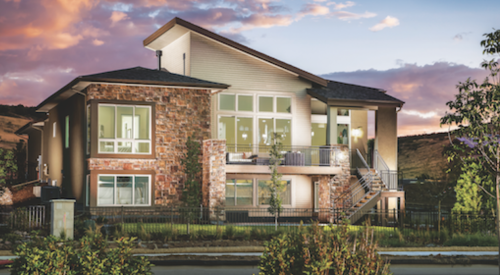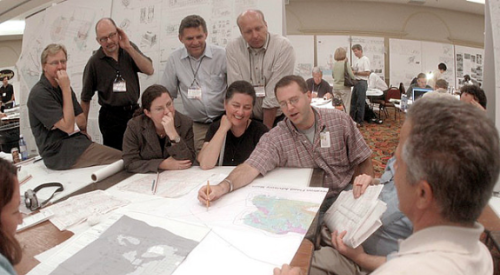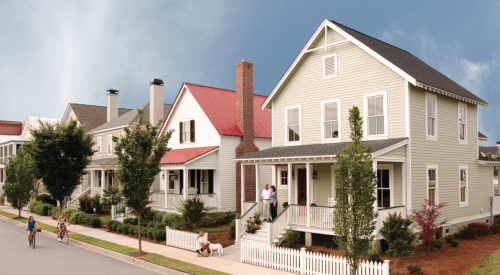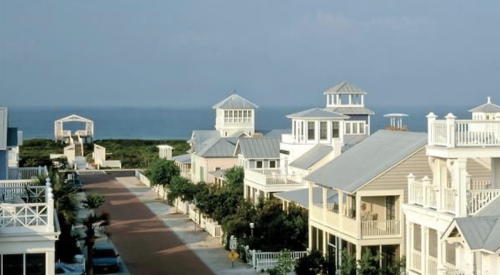|
With their two-story porches, tall shuttered windows and French doors, tight setbacks, mature trees and American flags, homes in Habersham look much like homes in any small town, including the nearby historic district in Beaufort, S.C.
|
|||||
|
You can’t pick up an industry magazine or even a newspaper, it seems, without reading about traditional neighborhood de-sign. It’s the topic of seminars at everything from local home builders associations to the International Builders’ Show. Certain consumers recognize the term TND and ask for it by name; to others, it’s just another acronym. But what does the growth of TND mean for you? Why should you care?
Three main reasons: TND’s appeal to changing demographics, growing market demand and, to a lesser degree, municipal acceptance of TND-friendly zoning.
In many ways, TND responds to shifting demographics better than traditional suburban developments do. According to the U.S. census, married couples with children younger than 18 accounted for only 24% of households in 2000, compared with 40% in 1970, and singles made up 26% of all households, compared with just 17% three decades earlier. During that same time, average household size shrank from 3.14 people to 2.62.
With an emphasis on mixing several housing types in each community — from single-family homes to townhomes to rental flats — TND offers a greater variety of housing options, attracting greater diversity. Hank Baker, senior vice president of marketing and economic development for Forest City Stapleton, sees that playing out at Stapleton, the developer’s TND community in Denver. Two-parent households with children make up just 20% of Stapleton buyers. “We have singles, empty nesters, gay and lesbian couples, and just about any other household formation you can imagine,” Baker says.
Research from the Funders’ Network for Smart Growth and Livable Communities, a network of charitable foundations, indicates that market demand for pedestrian-friendly, close-knit neighborhoods will increase dramatically during the coming years. The network commissioned the University of Southern California’s School of Policy, Planning and Development to assess market demand for “dense, walkable neighborhoods,” including but not limited to TND communities.
As described in the report “The Coming Demand,” the research found that during the 1990s, 15% of people preferred dense, walkable neighborhoods. By the end of this decade, the report says, 30% will prefer such neighborhoods, and that could jump to 55% depending on the effect of increased exposure to revitalized city neighborhoods and TND communities. The report cites factors such as the stress of increased traffic in low-density suburban areas, a desire for diversity and a preference for “traditional sidewalk shopping experiences” over malls as keys to the cultural shift toward New Urbanist development (see “The Congress for the New Urbanism,” page 110).
Certain municipalities accept TND as a viable and sometimes preferred growth alternative to what they and their constituents see as suburban sprawl. Although the vast majority of municipalities don’t specifically focus on TND — and many zoning codes restrict it — a November 2000 report from the Congress for the New Urbanism lists 39 municipalities, chiefly in North Carolina, Florida and Oregon, that have adopted or amended zoning and planning codes to promote New Urbanism.
On the other hand, TND doesn’t answer certain obvious questions. Has the American dream of owning a big home on a big lot on a safe street where kids can play away from big-city noise, density and traffic changed? No. The majority of Americans, voting with their dollars, still choose the typical suburban subdivision over a TND community.
Currently, the percentage of TND communities within the entire industry is unclear, with some placing it at 1% of the market and others as high as 10%. That makes it hard to get a handle on what building a TND community actually means and, more important, whether it’s a worthwhile choice for your business.
Securing Financing
Peter Katz, a TND consultant and co-founder of the CNU, says builders and developers face three key challenges in building TND: financing barriers, inflexible development regulation and citizens’ attitudes against growth, particularly in suburban areas.
Bankers generally evaluate proposed projects based on comparables — the success or failure of communities of similar size, product type and price within the area. For a TND pioneer, finding a comparable can be tough.
The National Town Builders Association (www.ntba.net), which is aimed strictly at builders and developers sharing best practices (as opposed to the CNU, whose constituency also includes lawyers, bankers, government officials and others), encourages its members to show potential investors examples of successful TND communities.
Land developer Bob Turner did his first TND project, New Point in Beaufort County, S.C., during the early 1990s. With no TND projects in his area, he flew bankers to Seaside in Walton County, Fla., one of the first and certainly most successful TND communities in the country.
By 1997, when Turner teamed with Stephen Davis, another experienced TND developer, to develop Habersham, also in Beaufort County, Turner could point to their own successful TND communities as examples.
To help finance Habersham, Turner and Davis, as Habersham Land Co. Inc., assembled private investors willing to buy lots early, and then they put that initial capital and some of Habersham Land’s alongside the bank’s capital. Some of the original investors bought lots at $50,000 and flipped them two years later for $250,000.
Joe Duckworth, a partner in Wayne, Pa.-based Arcadia Land Co., which he runs with Seaside founder Robert Davis, has been building homes and doing land deals for a long time, having led Giant home builders such as Toll Brothers and Realen Homes. He doesn’t find financing TNDs much different from financing anything else.
“To be a land developer, you have to be a creative financier, but there’s no magic to it,” Duckworth says. “Bankers look at my community, and I try to show them how similar it is to what I have been doing. They’re still single-family homes, still in great neighborhoods. All we’ve done is reduced the lot size, increased open space and often accessed the homes from the rear. That’s much less of a change than when I started building condominiums or townhomes.”
Getting Approvals
“Financing hasn’t been an issue for me,” Duckworth says. “The issue has been with jurisdictions seeing something new and not knowing what to do about it.”
When the vision for a project doesn’t sink in with city officials and staffs, Duckworth loads them on a bus and takes them to a successful TND community so they can see how it works firsthand. “We have several examples a bus trip away, and I’ve run three trips to projects in the Baltimore-Washington area, Lakelands and Kentlands [both in Gaithersburg, Md.] in particular.”
TND builders and developers often have trouble selling municipalities on increased density because planners often predetermine the allowable number of residential units per acre.
Builder/developer Kevin Rea says the strength and completeness of his architectural plans helped sell the city of Bend, Ore., on his proposed Village Wiestoria, which at 42 units on 7.2 acres was a lot denser than the surrounding neighborhoods of mostly 1950s subdivisions. Rea went into preliminary meetings in 1995 with a regulating plan developed with the help of Portland, Ore.-based LCA Town Planning and Architecture.
“When you go to get a plat approved, it’s usually only horizontally oriented,” Rea says. “In addition to the horizontal, we had a self-imposed village regulating plan [patterned after the one used in Seaside] to denote setbacks, building typology, how the buildings relate to each other and building envelopes.” Just a year later, Rea opened sales.
|
A big, livable front porch with a gazebo element shades this Habersham house while letting in cool breezes. In Habersham’s center, sidewalks separate houses from the street. Farther out, they give way to a more rural feel.
|
|
Habersham uses what developer Bob Turner calls an organic grid: The curved streets connect well while not conforming to the rectangular grid often associated with TND. James Habersham Boulevard flanks a row of live oaks that once defined the lane to a plantation house that sat on the site.
|
Not in My Back Yard
Another tactic allowed Rea to kill two birds with one stone. He organized several get-togethers with would-be neighbors of Village Wiestoria before even approaching the city.
“We worked on educating the community and were really careful to counteract potential NIMBYism,” says Rea. “We talked about the concept [of Village Wiestoria] without mentioning density.” Rea succeeded in getting neighbors’ approval and support, which spoke volumes to the city.
Now Bend mandates that developers submit signed minutes of neighborhood meetings in which the developers go over their vision for a proposed community. Rea endorses that process because it not only allows for community review of a design, but it also engenders respect.
The Purist Approach
Habersham hits almost all of TND’s critical areas as spelled out by the CNU (see “Defining TND,” page 106), al-though its retail component, made up of mostly live/work units, is just getting started. Habersham was zoned for a conventional subdivision with a mixed-use component when Habersham Land bought the land in 1997. Turner and Davis decided to change the land plan to TND to gain a market edge in the growing town of Beaufort.
The planning firm of Duany Plater-Zyberk & Co. helped Habersham Land turn a plan with one loop road sprouting more than 100 cul-de-sacs into what Turner calls an “organic grid.” In a twist on TND’s standard grid pattern, curving but connected streets wind around hundreds of huge live oaks.
The approach has worked so far. The roster of seven builders has closed 250 of Habersham’s potential 1,000 single- and multifamily homes since 1999. What might not seem like a quick pace to some is pretty good for a TND community. “It takes awhile to get the momentum up on TNDs,” Turner says. “It won’t happen overnight,” partly because buyers unfamiliar with TND worry about the homes’ future resale value.
TND sells not just a house but a different kind of community, so achieving critical mass takes longer. People can’t see the vision from just a few lonely houses. Turner helps get TND projects moving by selling homes at prices lower than in subsequent phases to attract pioneer buyers.
Just a quarter of the way through Habersham’s build-out, Turner sees payoffs, and they’ve come in many forms.
As in many places, concerns about water quality figure big in Beaufort. Habersham Land’s plan, which provides for open space between the housing and the nearby Broad River and Habersham Creek, got the city’s thumbs up because the greenbelts act as buffers, filtering storm water before it reaches the waterways.
Habersham Land also countered a common argument against TND — that narrow streets limit access by firetrucks and other emergency vehicles — by showing the city that a connected street plan improves upon the standard model. “Imagine one big circle with cul-de-sacs and one gated entrance,” Turner says. “If trees fell down in two places, the entire neighborhood would be cut off. With streets and alleys and connectivity, you’ve got 15 or more ways to go.”
But as all builders know, everything comes down to one thing: Show me the money. Habersham Land sees it. Turner, who sells lots to the seven guest builders, says some of the view lots have appreciated 100% a year, and interior lots and houses have appreciated at an average of 20%. The first houses sold for $140,000 and a year later went for $240,000.
|
Parks and marshes, which separate the homes from nearby Habersham Creek and the Broad River, help clean storm-water runoff before it reaches the water.
|
The New New Urbanism: Hybrids
As the TND model grows, it also evolves. TND “hybrids” come from mixing TND principles with those of conventional subdivisions. Rea and some other TND proponents say hybrids dilute the image of TND. Others, such as Katz and Turner, think hybridization — which often picks up the best and worst of both methods, Katz says — simply doesn’t work well.
Village Homes in Littleton, Colo., has succeeded in creating a model hybrid: the Village of Five Parks in the Denver suburb of Arvada.
As the city of Arvada pushed to “move away from cul-de-sac plans,” says Matt Osborn, Village Homes’ vice president of marketing operations, the company’s experience at Lowry, an urban infill community in Denver, revealed market acceptance for alley-loaded homes and walkable communities.
To make sure it nailed the community design, in 1997 Village Homes held a focus group made up of buyers who had purchased a home within the past 12 months. The builder presented the original, approved plan for Five Parks (Village had bought the parcel in ’97 already approved and zoned) with cul-de-sacs and a central 13-acre park as well as a strict, gridded TND plan with several smaller parks. The study re-vealed that buyers desired components of each.
The focus groups “loved the site plan and the multiple smaller parks — with the neighborhoods forming around those parks — and the walkability,” says Gary Ryan, Village’s senior vice president of community development. “Ultimately, the family buyers with growing children disliked giving up part of their rear yards for alleys, wanted cul-de-sacs and feared more through traffic.”
Village eventually went with a hybrid plan offering diverse product lines — two conventional single-family collections, two alley-loaded TND product lines, three “lifestyle” or active-adult areas (with two TND-oriented products and one detached patio home product), lofts in the village square and rental apartments. The conventional-to-TND distribution is 40% to 60%. As of March 29, 2004, conventional single-family de-tached accounted for 37% of total sales, TND single-family detached 42% and the lifestyle homes 21%.
Ryan calls the buyer mix fairly predictable. Families with children choose the conventional homes, and those without pick TND.
“The changing household composition portends different housing forms, including less child-centered organizational patterns. Older people and younger people, both without children, may be more influential in community design than they have been in the past,” says Ryan, who sees that as a fundamental shift in home building nationwide.
Osborn says the TND homes’ profit margins compare favorably with those for conventional. Several variables exist for each collection of homes — including development costs per lot, lot premiums and building costs per square foot — so a black-and-white comparison of profit margins for TND versus conventional doesn’t work. Without citing numbers, Osborn says the smallest TND product, the Cottage Collection, achieves the healthiest margin in Five Parks, despite a limited opportunity for lot premiums. He also says the TND lots cost less to develop than conventional, chiefly because the smaller acreage requires a much smaller allocation of major development improvement costs.
Comparable in size, price and lot premiums, the Heritage (TND) and Haven (conventional) bring in about the same margin, despite Heritage’s higher building costs — $60 to $67 per square foot versus Haven’s $56 to $63.
Although Village Homes doesn’t make more money on TND than on conventional in Five Parks, Osborn points out that mixing the two gives Five Parks an edge over other new home communities because it allows Village to draw from a more diverse buyer base.
|
The Chesapeake (left) and Provincetown models represent the TND side of the Village of Five Parks. Both Cottage Collection products are rear-loaded, feature traditional architecture and have a large, usable front porch.
|
When TND Doesn’t Work
Katz says many builders and developers “come to TND because the old game is over — they’re being blocked in some way from doing what they’ve been doing for the past 20 years. I’m hard-pressed to find a reason to tell a builder who’s doing fine building conventional subdivisions that they should go through the brain damage of doing TND.”
Building TND makes no sense for Dilsheimer Communities in Bala Cynwyd, Pa., near Philadelphia. Rather than butt heads with city officials for approvals and redesign his land plan and product to fit what the city had in mind, Dick Dilsheimer sold one of his parcels to Duckworth, who put a TND community on it.
“We build vanilla,” says Dilsheimer, who has built in suburban Philadelphia for more than 40 years. “We build tract housing, about 300 to 350 houses a year — that’s our niche. We felt resistance, and we didn’t want the pain of a protracted approval process.”
In many markets, builders can’t see how TND would sell in the suburbs and farther out. “We’ve developed a social structure in the suburbs that is not conducive to that,” says Leonard Besinger, president of Woodstone Corp. in Marengo, Ill., a town just beyond the Chicago metropolitan area. Large regional schools and big-box stores in sprawling shopping centers mean that people drive everywhere, he says. “People have so much invested in their cars, they’re not going to walk.”
TND also costs the builder and developer more, says Duckworth. TND entitlements cost 50% more and take two to three times longer, he says. Duckworth makes it work because of economies of scale, selling lots at the same price as those in a conventional subdivision, but selling more and smaller lots.
In addition to money, TND requires patience. Builders who try TND often pull out even before completing the first phase. If sales velocity doesn’t match the pro forma, builders switch gears, often completing the community in a conventional style.
Still, diehard New Urbanists believe that not only is TND here to stay, but also that its future lies with large home builders equipped with the capital to build on a large scale and hire the best talent. Duckworth predicts that within five to 10 years, TND will make up 25-30% of all home building and that high-volume builders will be the ones doing it.
Duckworth and others send this message to small and middle-volume developers: Business as usual might suit your business needs now, but if market demand or regulations push you to do something different, TND just might be the right niche at the right time.
Better get in while the getting’s good.
To help spell out what it means to be a TND community, the Congress for the New Urbanism provides a rubric for evaluating project “purity.”
In 1993, 170 designers, including Peter Calthorpe, Andres Duany, Elizabeth Moule, Stefanos Polyzoides, Elizabeth Plater-Zyberk and Daniel Solomon, met to share ideas and compare the attributes of various urban and suburban places. The group, with the help of organizer Peter Katz, founded the Congress for the New Urbanism, a nonprofit organization that advocates building new communities modeled on the structure of traditional neighborhoods.
From 1993 to ’96, the CNU developed a charter that explains its mission and goals toward “the restoration of existing urban centers and towns within coherent metropolitan regions, the reconfiguration of sprawling suburbs into communities of real neighborhoods and diverse districts, the conservation of natural environments and the preservation of our built legacy.” TND communities are integral to New Urbanism.
A decade later, the CNU claims that 210 such communities are under way or complete. Its Web site, www.cnu.org, provides a comprehensive list of CNU Charter Award-winning communities and a voluntary clearinghouse of hundreds of projects whose developers claim the use of New Urbanist principles.












